 W
WVegetarian cuisine is based on food that meets vegetarian standards by not including meat and animal tissue products. For lacto-ovo vegetarianism, eggs and dairy products are permitted. For lacto vegetarianism, dairy products are permitted but eggs are not, and for ovo vegetarianism eggs are permitted but dairy products are not. The strictest form of vegetarianism is veganism, which excludes all animal products, including dairy, honey, and some refined sugars if filtered and whitened with bone char. There are also partial vegetarians (flexitarians), such as pescetarians who may eat fish but avoid other types of meat.
 W
WAn edible seed is a seed that is suitable for human or animal consumption. Of the six major plant parts, seeds are the dominant source of human calories and protein. A wide variety of plant species provide edible seeds; most are angiosperms, while a few are gymnosperms. As a global food source, the most important edible seeds by weight are cereals, followed by legumes, nuts, then spices.
 W
WAjapsandali, or ajapsandal is a traditional Azerbaijani, Georgian and Armenian dish, also popular in the Northern Caucasus. It consists of onion, eggplant, tomato and bell pepper stewed or fried in vegetable oil and seasoned with garlic, basil, coriander leaves, parsley and other seasoning. Sometimes potato, chili pepper and even carrots are added although traditional recipes don't include them.
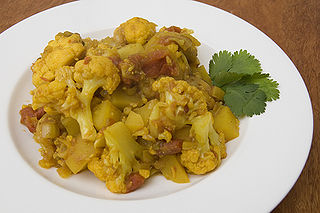 W
WAloo gobi is a vegetarian dish from the Indian subcontinent made with potatoes (aloo), cauliflower, and Indian spices. It is popular in Indian and Pakistani cuisines. It is yellowish in colour, due to the use of turmeric, and occasionally contains kalonji and curry leaves. Other common ingredients include garlic, ginger, onion, coriander stalks, tomato, peas, and cumin. There are a number of variations and similar dishes, but the name remains the same.
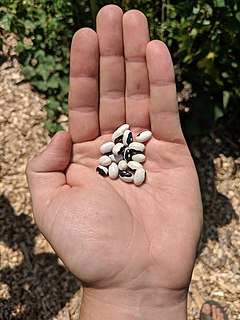 W
WA bean is the seed of one of several genera of the flowering plant family Fabaceae, which are used as vegetables for human or animal food. They can be cooked in many different ways, including boiling, frying, and baking, and are used in many traditional dishes throughout the world.
 W
WThe black turtle bean is a small, shiny variety of the common bean especially popular in Latin American cuisine, though it can also be found in the Cajun and Creole cuisines of south Louisiana. Like all varieties of the common bean, it is native to the Americas, but has been introduced around the world. It is also used in Indian cuisine, Tamil cuisine, where it is known as karuppu kaaramani and in Maharashtrian cuisine, where it is known as Kala Ghevada. The black turtle bean is often simply called the black bean, although this terminology can cause confusion with other black beans.
 W
WBolani Periki is a flat-bread from Afghanistan, baked or fried with a vegetable filling. It has a thin crust and can be stuffed with a variety of ingredients, such as potatoes, lentils, pumpkin, chives, or leeks. It can be served with plain yogurt or mint yogurt.
 W
WA Buddha bowl is a vegetarian meal, served on a single bowl or high-rimmed plate, which consists of small portions of several foods, served cold. These may include whole grains such as quinoa or brown rice, plant proteins such as chickpeas or tofu, and vegetables. The portions are not mixed on the plate or in the bowl, but arranged in an "artful" way. The concept appeared in 2013 and has grown popular since early 2017. Buddha bowls have been compared to Nourish Bowls and to Poké Bowls.
 W
WCarrot salad is a salad made with carrots. Recipes for carrot salad vary widely by regional cuisine. Shredded carrot is often used. Shredded carrot salads are often used as a topping for other dishes.
 W
WColcannon is a traditional Irish dish of mashed potatoes with kale or cabbage.
 W
WConfit byaldi is a variation on the traditional French dish ratatouille by French chef Michel Guérard.
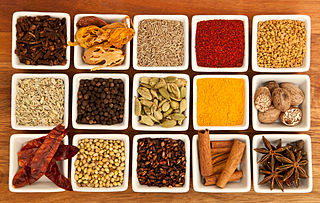 W
WThe cuisine of Karnataka includes the cuisines of the different regions and communities of Karnataka, namely, North Karnataka cuisine, South Karnataka cuisine, Udupi cuisine, Saraswat cuisine, Coorg cuisine, Mangalorean Catholic cuisine and Navayath cuisine.
 W
WEdible mushrooms are the fleshy and edible fruit bodies of several species of macrofungi. They can appear either below ground (hypogeous) or above ground (epigeous) where they may be picked by hand. Edibility may be defined by criteria that include absence of poisonous effects on humans and desirable taste and aroma.
 W
WEma datshi is among the most famous dishes in Bhutanese cuisine, recognized as a national dish of Bhutan. It is made from hot chili peppers and cheese; "ema" means "chili" and "datshi" means "cheese" in the Dzongkha language of Bhutan.
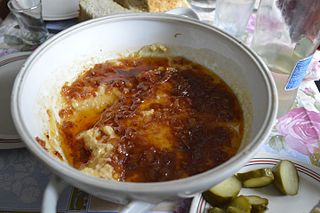 W
WFasole bătută or fasole făcăluită or icre de fasole is a bean-based paste. This dip is traditionally made by mashing boiled beans and mixing them with vegetable oil, then adding some chopped onions. Some recipes call for garlic, chili pepper, lime or lemon juice, and additional seasonings.
 W
WFlat beans, also known as helda beans, romano beans and "sem fhali" in some Indian states, are a variety of Phaseolus coccineus, known as runner bean with edible pods that have a characteristic wide and flat shape. Flat beans are normally cooked and served as the whole pods, the same way as other green beans. Like many other types of bean they can also be dehusked or shelled and the whitish seeds dried and stored, but there is no incentive to grow them for this purpose as higher-yielding bean varieties are available.
 W
WFried cauliflower is a popular dish in many cuisines of the Middle East, South Asia, Europe, and elsewhere. It may start from raw or cooked cauliflower; it may be dipped in batter or breading; it may be fried in oil, butter, or other fats. It can be served on its own, as a mezze or side dish, or in a sandwich. It is often seasoned with salt, spices, and a variety of sauces, in the Middle East often based on tahini or strained yogurt.
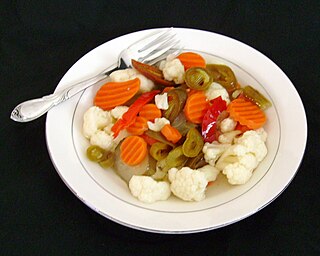 W
WGiardiniera is an Italian relish of pickled vegetables in vinegar or oil.
 W
WHalva are dense, sweet confections originating in the Middle East. The word is mainly used to describe two different types of desserts: a gelatinous confection made from flour, clarified butter (ghee) and sugar; or a crumbly nut-butter-based product often made from tahini and sugar. Halva may also be based on various other ingredients, including beans, lentils, and vegetables such as carrots, pumpkins, yams and squashes.
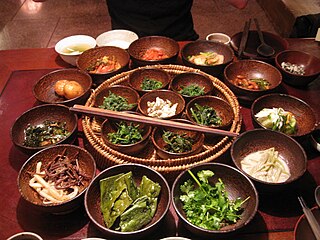 W
WKorean temple cuisine refers to a type of cuisine that originated in Buddhist temples of Korea. Since Buddhism was introduced into Korea, Buddhist traditions have strongly influenced Korean cuisine as well. During the Silla period, chalbap yakgwa and yumilgwa were served for Buddhist altars and have been developed into types of hangwa, Korean traditional confectionery. During the Goryeo Dynasty, sangchu ssam, yaksik, and yakgwa were developed, so spread to China and other countries. Since the Joseon Dynasty, Buddhist cuisine has been established in Korea according to regions and temples.
 W
WKoya-dofu also known as Shimi-dofu, Kori-dofu, or Koyasan-dofu is frozen-dried tofu, a Japanese pantry staple and an important ingredient in Buddhist vegetarian cookery. It originated from Japan. It is made of soy, coagulants, and baking soda. It looks like a hard sponge and needs to be soaked before use. It is mainly used in stews and soups.
 W
WKwarezimal is a traditional Maltese recipe, usually baked during Lent. They contain flour, sugar, orange rind and ground almonds(intrita). They are vegan, since they contain no animal protein, eggs, or dairy products.
 W
WLanttulaatikko or kålrotslåda is a swede (rutabaga) casserole that is a traditional Christmas dish of Finland. It is usually served with a few other casseroles at the Christmas table as a side dish to ham, fish or other meats.
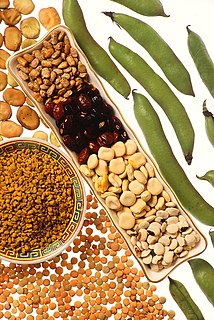 W
WA legume is a plant in the family Fabaceae, or the fruit or seed of such a plant. The seed is also called a pulse. Legumes are grown agriculturally, primarily for human consumption, for livestock forage and silage, and as soil-enhancing green manure. Well-known legumes include alfalfa, clover, beans, peas, chickpeas, lentils, lupins, mesquite, carob, soybeans, peanuts, and tamarind. Legumes produce a botanically unique type of fruit – a simple dry fruit that develops from a simple carpel and usually dehisces on two sides.
 W
WA lettuce sandwich is a wrap with lettuce substituted for the bread, or a sandwich with a filling consisting primarily of lettuce. It should not be confused with other sandwiches that use lettuce as one of many ingredients, such as the BLT sandwich or the tomato and lettuce sandwich. The lettuce sandwich has a long history in both the United States and the United Kingdom. It has been used as a metaphor to represent things like mundanity, weakness and poverty.
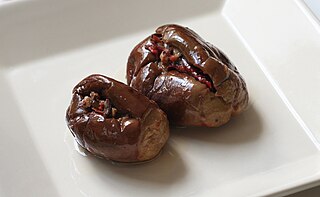 W
WMakdous is a dish of oil-cured aubergines. Part of Iraqi and Levantine cuisine, they are tiny, tangy eggplants stuffed with walnuts, red pepper, garlic, olive oil and salt. Sometimes chilli powder is added.
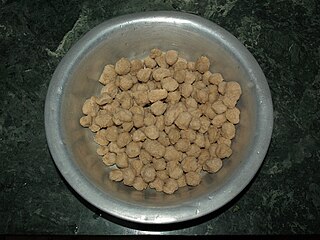 W
WMasaura is sun-dried vegetable balls made with a combination of various or single minced vegetables with black lentils. The choice of vegetables is mostly taro, yam, and colocasia leaf. As finding fresh vegetables was a hard all-around year in the earlier days, masaura become an alternative nutritious food item when fresh vegetables weren’t available. Masaura also can be compared with soy-chunks. Where Soy-chunks is made from soybean and Masaura is made with minced vegetables. Masaura is fried in oil.
 W
WA meat analogue is a meat-like substance made from plants. More common terms are plant-based meat, vegan meat, meat substitute, mock meat, meat alternative, imitation meat, or vegetarian meat, or, sometimes more pejoratively, fake meat or faux meat. Meat analogues typically approximate certain aesthetic qualities or chemical characteristics of specific types of meat. Generally, meat analogue means a food made from vegetarian ingredients, and sometimes without animal products such as dairy. Many analogues are soy-based or gluten-based, but now may also be made from pea protein. Other less common analogues include ingredients like mycoprotein.
 W
WA meat-free sausage roll is a savoury pastry snack that contains a non-meat filling. The snack is an alternative to the conventional sausage roll that generally contains pork or beef. Meat-free sausage rolls are sold at retail outlets and are also available from bakeries as a take-away food.
 W
WMish-mash is a Bulgarian spring dish made with fresh vegetables, eggs and feta cheese, often garnished with freshly cut parsley. There are variations in which garlic, scallions, eggplants, okras or carrots are added to the dish. There are variations without feta cheese and without onion as well.
 W
WIn cuisine, dry nuts are dry, edible fruits or seeds that usually, but not always, have a high fat content.
 W
WA nut roast or roasted nut loaf is a vegetarian dish consisting of nuts, grains, vegetable oils, broth or butter, and seasonings formed into a firm loaf shape or long casserole dish before roasting and often eaten as an alternative to a traditional British style roast dinner. It is popular with vegetarians at Christmas, as well as part of a traditional Sunday roast. Nut roasts are also made by Canadian and American vegetarians and vegans as the main dish for Thanksgiving or other harvest festival meals.
 W
WOkara, soy pulp, or tofu dregs is a pulp consisting of insoluble parts of the soybean that remain after pureed soybeans are filtered in the production of soy milk and tofu. It is generally white or yellowish in color. It is part of the traditional cuisines of Japan, Korea, and China. Since the 20th century, it has been used in the vegetarian cuisines of Western nations.
 W
WOncom is one of the traditional staple foods of West Java (Sundanese) cuisine of Indonesia. There are two kinds of oncom: red oncom and black oncom. Oncom is closely related to tempeh; both are foods fermented using mold.
 W
WPaneer or Indian cottage cheese is a fresh cheese common in the Indian subcontinent. It is a non-aged, non-melting soft cheese made by curdling milk with a fruit- or vegetable-derived acid, such as lemon juice. Its acid-set form before pressing is called chhena.
 W
WPasta con i peperoni cruschi is an Italian pasta dish typical of the Basilicata region.
 W
WPasta primavera is an American dish that consists of pasta and fresh vegetables, invented in the 1970s.
 W
WPatatnik or patetnik is a Bulgarian potato dish characteristic of the Rhodope Mountains in the country's central south. Patatnik is made of grated potatoes, onions, salt and a type of very mild mint called Gyosum in Bulgarian, all mixed and cooked on a slow fire. Some restaurants add sirene or eggs, but this is not traditional; some people also use savory and peppers.
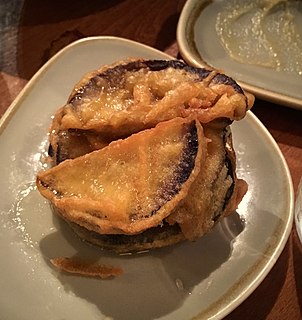 W
WFried eggplant is featured in dishes of many different cuisines.
 W
WPorkkanalaatikko is a traditional Finnish dish mostly eaten during Christmas.
 W
WRolex is a popular food item in Uganda, combining an egg omelette and veggies wrapped in a chapati. This single-portion dish is quick to prepare, and can be eaten at any time of the day, from breakfast to a lunch or supper meal or snack. The name "rolex" comes from its method of preparation, with the chapati and the omelette rolled together.
 W
WRösti or rööschti is a Swiss dish consisting mainly of potatoes, in the style of a fritter. It was originally a breakfast dish, commonly eaten by farmers in the canton of Bern, but is now eaten all over Switzerland and around the world. The French name röstis bernois makes direct reference to the origins of the dish.
 W
WSoft Khichuri, also known as Norom Kisuri is one kind of rice-based meal which is similar in consistency to porridge, a popular dish in the Sylhet region of Bangladesh. It is a traditional food in Sylheti cuisine that is served most dinner tables during the holy month of Ramadan. Being a staple food for iftar, Soft Khichuri at home and Akhni for serving the guest is a tradition of Sylhet. Aromatic rice mixing with various spices including ghee, kalozira and fenugreek to cook Kisuri. There are two types of Soft Khichuri; white soft khichuri (jau/zau) and yellow soft khichuri (kisuri). Chana, Chickpea, piyaju, Bakarkhani, potato chops, egg chops, Beguni, vegetables and leaf pakora, Jalebi, Sharbat, phirni are the side dishes of Sylheti Iftar items. Among the sweetmeats, Sylhet's specialty is Imarti. It is specially made of without any food color for Iftari. Though it looks like jilapi, there is a difference between them in size and taste.
 W
WSweet Tomatoes, operating as Souplantation in southern California, was a United States-based chain of all-you-can-eat buffet-style restaurants. The first location opened in 1978 in San Diego, California, where the company was headquartered. The company was incorporated as Garden Fresh Corp. in 1983. The company went public in 1995 but was taken private in 2004. The company, owned by Garden Fresh Restaurant Corporation, temporarily closed its 97 locations in March 2020 because of uncertainty due to the COVID-19 pandemic. On May 7, 2020, the closure was made permanent and the company filed for liquidation.
 W
WSour cherry soup is a slightly sweet soup made with sour cream, sugar and whole fresh sour cherries, and served chilled. Originating in Hungarian cuisine, this soup is a summer delicacy in several European cuisines.
 W
WSpanakorizo is a Greek vegetarian dish of spinach and rice. A pilaf, it is described as a typical Greek country dish that may be eaten hot or cold.
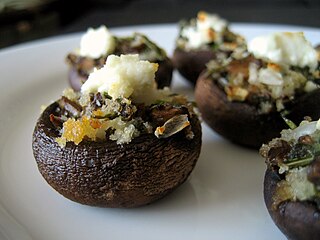 W
WStuffed mushrooms is a dish prepared using edible mushrooms as its primary ingredient. Many fillings can be used, and the dish is typically baked or broiled. It can be served hot or at room temperature, and is sometimes served cold. The dish can have a meaty texture, and serves as an hors d'oeuvre, side dish, or snack.
 W
WSuccotash is a culinary dish consisting primarily of sweet corn with lima beans or other shell beans. Other ingredients may be added including corned beef, potatoes, turnips, salt pork, tomatoes, multi-colored sweet peppers, and okra. Combining a grain with a legume provides a dish that is high in all essential amino acids. Because of the relatively inexpensive and more readily available ingredients, the dish was popular during the Great Depression in the United States. It was sometimes cooked in a casserole form, often with a light pie crust on top as in a traditional pot pie.
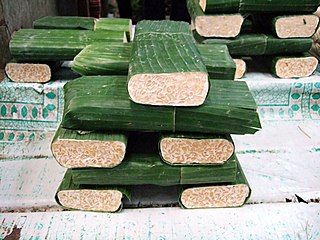 W
WTempeh or tempe is a traditional Indonesian soy product that is made from fermented soybeans. It is made by a natural culturing and controlled fermentation process that binds soybeans into a cake form. Here a special fungus is used, which has the Latin name Rhizopus oligosporus, usually marketed under the name tempeh starter.
 W
WTexas caviar is a salad of black-eyed peas lightly pickled in a vinaigrette-style dressing, often eaten as a dip accompaniment to tortilla chips. Texas caviar was created in the U.S. state of Texas around 1940 by Helen Corbitt, a native New Yorker who later became director of food service for the Zodiac Room at Neiman Marcus in Dallas, Texas. She first served the dish on New Year's Eve at the Houston Country Club. When she later served it at the Driskill Hotel in Austin, Texas, it was given its name, "Texas caviar," as a humorous comparison to true caviar, an expensive hors d'oeuvre of salt-cured fish roe. It has also been called cowboy caviar.
 W
WA tomato omelette is a breakfast dish prepared mostly in Maharashtra. It is referred to as an omelette because of its visual appearance, but actually contains no egg product or by-product. The main ingredient is chickpea flour or besan. Sometimes, it is also made with dosa batter, with a small quantity of besan only to provide binding, in which case it is classified as Uttapam.
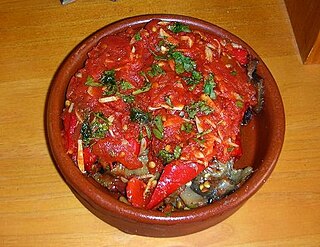 W
WTombet or tumbet is a traditional vegetable dish from Majorca, consisting of layers of sliced potatoes, aubergines and red bell peppers previously fried in olive oil. It is available at almost every local restaurant on the island.
 W
WVada pav, alternatively spelt wada pao, (listen) is a vegetarian fast food dish native to the state of Maharashtra. The dish consists of a deep fried potato dumpling placed inside a bread bun (pav) sliced almost in half through the middle. It is generally accompanied with one or more chutneys and a green chili pepper. Although it originated as cheap street food in Mumbai, it is now served in food stalls and restaurants across India. It is also called Bombay burger in keeping with its origins and its resemblance in physical form to a burger.
 W
WVegetable sandwich is a type of vegetarian sandwich consisting of a vegetable filling between bread. There are no set requirements other than the use of vegetables, and sandwiches may be toasted or untoasted. Vegetable sandwiches are served throughout the world and are a popular street food in India.
 W
WChili con carne, meaning 'chili with meat', is a spicy stew containing chili peppers, meat, and often tomatoes and beans. Other seasonings may include garlic, onions, and cumin. The dish originated in northern Mexico or southern Texas.
 W
WA veggie burger is a burger patty that does not contain meat. These burgers may be made from ingredients like beans, especially soybeans and tofu, nuts, grains, seeds or fungi such as mushrooms or mycoprotein.
 W
WWaakye is a Ghanaian dish of cooked rice and beans, commonly eaten for breakfast or lunch. However, others eat it for supper. The rice and beans, usually black eyed peas or cow beans, are cooked together, along with red dried sorghum leaf sheaths or stalks and limestone. The sorghum leafs and limestone give the dish its characteristic flavor and a red appearance and the sorghum is taken out before consumption. The word waakye is from the Hausa language and means beans. It is the contracted form of the full name shinkafa da wake which means rice and beans.
 W
WWheat gluten is a food made from gluten, the main protein of wheat. It is made by washing wheat flour dough with water until all the starch granules have been removed, leaving the sticky insoluble gluten as an elastic mass, which is then cooked before being eaten.
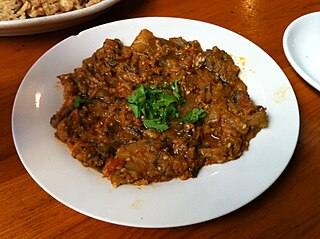 W
WZaalouk or Zalouk is a Moroccan salad of cooked aubergine and tomatoes. The eggplant is first grilled and then mixed with the tomatoes and the mix is seasoned with garlic and spices.